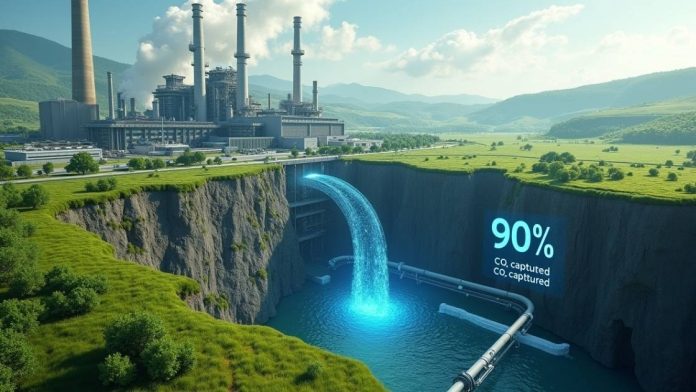Now, Imagine having a vacuum cleaner for the sky—one that sucks harmful carbon dioxide right out of the atmosphere and locks it away forever. Sounds like science fiction, right?
Well, welcome to the science of right now.
Carbon Capture and Storage (CCS) is one of the most promising tools in our fight against climate change. As industries and nations scramble to reduce their carbon footprints, CCS is quietly stepping up as a real-world superhero—capturing emissions before they ever hit the atmosphere.
But how does it work, and can it really save us? Let’s explore the fascinating world of CCS and how this technology is shaping the future of a greener, more breathable planet.
Why Carbon Capture and Storage Is a Big Deal
Let’s get real. Despite all our efforts—renewable energy, electric cars, eco-conscious lifestyles—we’re still pumping out over 35 billion tons of CO₂ every year.
And most of that comes from:
-
Power plants burning coal and gas
-
Heavy industries like cement and steel
-
Transportation and manufacturing
These emissions are the invisible enemy warming our planet, melting our glaciers, and turning our weather upside down.
That’s why scientists and environmentalists are turning to CCS—not as a silver bullet, but as a critical piece of the climate puzzle.
What Is Carbon Capture and Storage (CCS)?
CCS refers to a suite of technologies that:
-
Capture CO₂ at the source (before it’s released into the air).
-
Transport it via pipelines, ships, or trucks.
-
Store it safely underground—often in old oil fields, saline aquifers, or deep rock formations.
And here’s the kicker: when done right, it can prevent up to 90% of emissions from certain facilities. That’s massive.
How CCS Works: A Simple Breakdown
1. Capture
There are three main types:
-
Pre-combustion capture: CO₂ is removed before the fuel is burned.
-
Post-combustion capture: CO₂ is scrubbed from flue gases after burning.
-
Oxy-fuel combustion: Fuel is burned in oxygen, making CO₂ easier to isolate.
2. Transport
Once captured, CO₂ is compressed into a liquid-like state and moved through:
-
Pipelines (most common)
-
Ships (for offshore storage)
-
Trucks (for small-scale operations)
3. Storage
The CO₂ is then injected into deep geological formations, often more than 1km underground. These formations trap CO₂ for thousands of years without leaks—similar to how oil and gas have been stored naturally for millions of years.
Where Is CCS Being Used Today?
CCS is no longer experimental. It’s already in action in several countries:
-
Norway’s Sleipner Project has been storing CO₂ under the North Sea since 1996.
-
Canada’s Boundary Dam power station captures about 1 million tons of CO₂ annually.
-
The United States has dozens of projects across energy and industrial sectors.
Even oil companies are joining in—not just to store CO₂, but to use it for enhanced oil recovery (EOR), extracting more crude from old wells while locking the carbon underground.
Actionable Tips: How You Can Support or Get Involved in CCS
Yes, CCS is a big-tech, big-industry tool. But individuals still play a vital role. Here’s how you can get involved:
1. Support Climate-Friendly Policies
Vote for leaders and policies that prioritize carbon capture and clean energy investment.
2. Push for Transparency
Encourage companies to disclose their carbon emissions and offset strategies—including CCS.
3. Invest with Purpose
Consider green bonds or ETFs that fund clean technology and sustainable infrastructure, including CCS.
4. Educate Others
Share articles, attend webinars, or host community talks about emerging climate tech. Awareness fuels action.
5. Cut Your Own Carbon Footprint
While CCS fights emissions at the industrial level, you can make a difference with sustainable habits—lower energy use, reduced meat consumption, and mindful transportation choices.
CCS: A Solution or a Distraction?
Let’s address the elephant in the room. Some critics argue that CCS could give polluters a license to continue harmful practices under the illusion of “clean emissions.”
And that’s a valid concern.
But here’s the truth: while we absolutely need to reduce emissions at the source, we also need tools to deal with the carbon we’ve already emitted—and the hard-to-avoid emissions from heavy industries.
So, CCS isn’t an excuse. It’s a bridge—one that can help us buy time as we transition to a truly low-carbon world.
FAQs About Carbon Capture and Storage
1. Is CCS safe?
Yes. When done properly, geological storage of CO₂ is extremely safe and stable. It’s regulated and monitored to prevent leaks.
2. Is CCS a new technology?
Nope! It’s been used for decades, especially in the oil industry. What’s new is its expanded role in climate solutions.
3. How much does CCS cost?
It varies. Right now, it’s more expensive than doing nothing—but costs are falling as technology improves and scales up.
4. Can CCS work with renewable energy?
Yes! In fact, pairing CCS with bioenergy (BECCS) can result in negative emissions—removing CO₂ from the atmosphere.
5. Will CCS alone solve climate change?
Not at all. It’s just one tool in the toolbox. We need a mix of renewables, energy efficiency, reforestation, and lifestyle changes too.
Final Thoughts
CCS won’t solve climate change overnight. But it will help reduce the carbon overload that’s warming our planet. It’s a technology that tells us, “Yes, we’ve made mistakes—but we have the tools to fix them.”
The more we invest in CCS now—through policy, innovation, and public support—the better our chances of keeping global warming in check.
So, let’s keep the momentum going.
🌍 Are you excited or skeptical about carbon capture and storage?
💬 Have you heard of any CCS projects near your city or country?
⏳ How do you manage your time when trying to live a greener life?
Drop your thoughts in the comments below! Let’s swap strategies, share insights, and build a climate-smart community—one conversation at a time.

